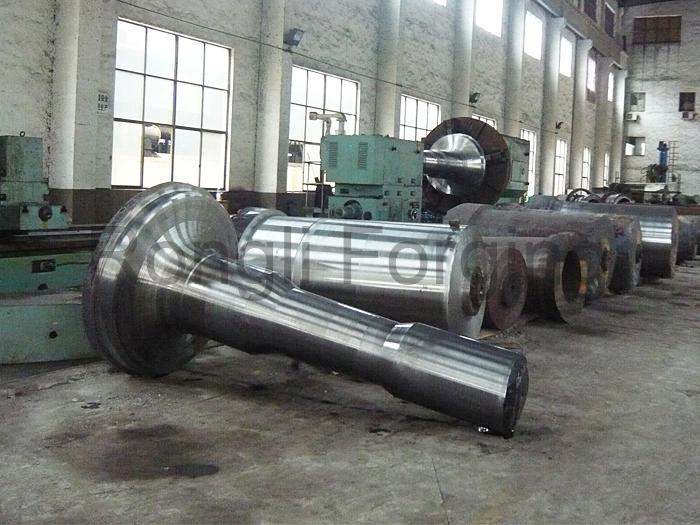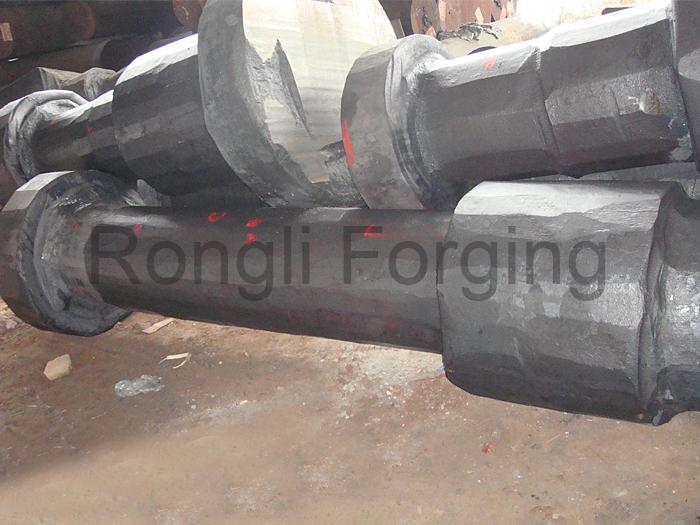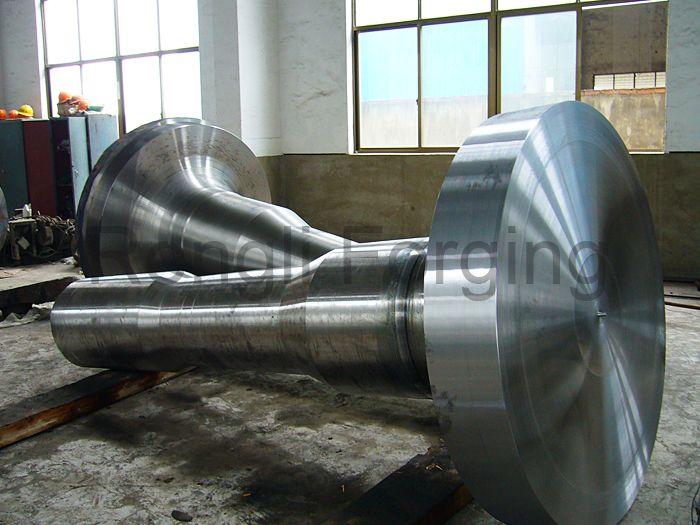
When I think about the advantages of the Free-die forged wind turbine shaft, several key benefits come to mind. These shafts stand out for their exceptional strength and durability, making them perfect for the demanding environments of wind energy projects. I’ve seen firsthand how a quality forging wind turbine shaft can enhance overall project outcomes. Not only do they improve reliability, but they also contribute to the efficiency of the entire system. Choosing a trusted forging wind turbine shaft factory like Rongli Forging Co., Ltd ensures that you receive top-notch components, including the forging wind power generator shaft, that can withstand the test of time.
Key Takeaways
- Free-die forged wind turbine shafts offer exceptional strength and durability, making them ideal for harsh wind energy environments.
- Investing in these shafts leads to long-term savings due to their reduced maintenance needs and extended lifespan.
- Customization options allow these shafts to be tailored for specific project requirements, enhancing performance and reliability.
- Sustainable manufacturing practices, such as recycling and energy efficiency, make these shafts an environmentally friendly choice.
- Choosing high-quality forged shafts ensures better project outcomes and contributes to the growth of renewable energy.
Durability of Free-die Forged Wind Turbine Shafts

Enhanced Strength
When I think about the strength of free-die forged wind turbine shafts, I can’t help but be impressed. These shafts are crafted from high-quality materials, like quenched-and-tempered 34CrNiMo6 alloy steel. This choice makes a significant difference. In fact, shafts made from this material show a remarkable 40% higher fatigue resistance compared to those made from AISI 1045 carbon steel. This means they can handle the stresses of wind energy generation much better.
The IEC 61400-22 certification standards require that these shafts have a fatigue life exceeding 20 years under cyclic loading. This requirement pushes manufacturers to select materials that not only meet but exceed these standards. I’ve seen how advanced manufacturing techniques play a crucial role in achieving this level of performance. It’s reassuring to know that when I choose a free-die forged wind turbine shaft, I’m opting for a product that stands up to rigorous testing and meets evolving safety and performance standards.
Longevity in Harsh Conditions
I’ve also noticed that free-die forged wind turbine shafts excel in extreme weather conditions. These shafts are designed to endure severe environments, thanks to their high tensile strength and impact toughness. The materials used in their construction undergo extensive testing to ensure they can withstand everything from heavy winds to freezing temperatures.
For instance, I’ve come across numerous cases where these shafts have performed reliably in challenging climates. Their robust design means they don’t just survive; they thrive, ensuring that wind turbines operate efficiently even when Mother Nature throws her worst at them. This reliability is vital for maximizing energy production and minimizing downtime, which ultimately leads to better project outcomes.
Choosing a free-die forged wind turbine shaft means investing in a component that offers both strength and longevity. It’s a decision I feel confident about, knowing that these shafts are built to last and perform under pressure.
Cost-Effectiveness of Free-die Forged Wind Turbine Shafts
When I think about the cost-effectiveness of free-die forged wind turbine shafts, I see a clear picture of value over time. Many people might worry about the initial investment, but I’ve learned that this is just the beginning of the story.
Initial Investment vs. Long-term Savings
Sure, the upfront cost of a free-die forged wind turbine shaft can seem high. However, I’ve found that this investment pays off in the long run. Here’s why:
- Durability: These shafts are built to last. Their enhanced strength means they can handle the rigors of wind energy generation without needing frequent replacements.
- Performance: A well-made shaft contributes to the overall efficiency of the wind turbine. This efficiency translates into more energy produced over time, which can lead to significant savings.
- Resale Value: If you ever decide to upgrade or replace your equipment, high-quality forged shafts often retain their value better than cheaper alternatives.
I’ve seen projects where the initial investment in quality components led to lower operational costs and higher returns. It’s like buying a good pair of shoes; you might spend a bit more upfront, but they last longer and keep your feet comfortable.
Reduced Maintenance Costs
Another aspect that stands out to me is the reduced maintenance costs associated with free-die forged wind turbine shafts. I’ve noticed that these shafts require less frequent servicing compared to other options. Here’s what I mean:
- Fewer Breakdowns: The robust design and high-quality materials mean that these shafts are less likely to fail. This reliability reduces the need for emergency repairs, which can be costly and time-consuming.
- Lower Labor Costs: With fewer maintenance issues, you save on labor costs. Technicians spend less time fixing problems and more time focusing on other important tasks.
- Extended Lifespan: The longevity of these shafts means you won’t have to replace them as often. This not only saves money but also minimizes downtime, allowing your wind turbines to operate efficiently.
In my experience, investing in a free-die forged wind turbine shaft is a smart choice. The combination of initial investment and long-term savings creates a compelling case for these components. They not only enhance project outcomes but also contribute to a more sustainable and cost-effective energy solution.
Customization of Free-die Forged Wind Turbine Shafts

When it comes to customization, I find that free-die forged wind turbine shafts truly shine. These shafts can be tailored to meet specific project needs, which is a game-changer in the renewable energy sector.
Tailored Designs for Specific Needs
I’ve seen firsthand how engineering specifications for these shafts accommodate different load and size requirements. For example, the design of hollow rotor shafts is optimized based on load conditions and material properties. This means that when I work on a project, I can rely on the shaft’s design to handle critical bending moments, which are essential for preventing fatigue damage.
Here are some key aspects of tailored designs:
- The trumpet section of the shaft is specifically focused on due to high stress from shear force induced bending moments.
- Finite element simulations help evaluate principal stresses for various trumpet geometries. This ensures we achieve a lightweight design while maximizing material utilization.
- The design process involves defining outer and inner geometries to manage stress effectively.
This level of customization allows me to ensure that the shafts I choose will perform optimally under the specific conditions they will face.
Flexibility in Production
Another aspect I appreciate is the flexibility in production. The ability to make rapid adjustments from prototyping to mass production means manufacturers can quickly respond to design changes or production needs. This adaptability is crucial for ensuring that components are delivered on time, which directly influences project scheduling and overall delivery efficiency.
I’ve noticed that this flexibility not only helps in meeting deadlines but also supports the integration of new turbine technologies. The durability and reliability of forged shafts lead to reduced maintenance needs and downtime, which is essential for the performance of larger wind turbines. Plus, advancements like AI-powered quality control enhance manufacturing precision, resulting in more efficient and reliable turbines.
In my experience, choosing a free-die forged wind turbine shaft means investing in a product that can be customized to fit my project’s unique requirements while also benefiting from a flexible production process.
Environmental Impact of Free-die Forged Wind Turbine Shafts
When I think about the environmental impact of free-die forged wind turbine shafts, I feel a sense of responsibility. These shafts not only contribute to renewable energy but also come from sustainable manufacturing practices.
Sustainable Manufacturing Practices
I’ve learned that the production of free-die forged wind turbine shafts emphasizes sustainability. Manufacturers like Rongli Forging Co., Ltd focus on reducing waste and energy consumption during the forging process. Here are some key practices I’ve noticed:
- Recycling Materials: Many manufacturers use recycled materials in their production. This reduces the need for new raw materials and minimizes environmental impact.
- Energy Efficiency: The forging process has become more energy-efficient. Advanced machinery and techniques help lower energy consumption, which is crucial for reducing carbon footprints.
- Waste Management: Companies are adopting better waste management practices. They recycle scrap metal and other by-products, ensuring that as little as possible goes to landfills.
I appreciate how these practices not only help the environment but also align with the growing demand for sustainable solutions in the energy sector.
Lifecycle Assessment Benefits
Another aspect that stands out to me is the lifecycle assessment of free-die forged wind turbine shafts. This assessment evaluates the environmental impact of a product from its creation to its end-of-life. Here’s what I’ve found:
- Reduced Environmental Footprint: By analyzing the entire lifecycle, manufacturers can identify areas to improve. This leads to a lower overall environmental footprint for the shafts.
- Durability and Longevity: The robust nature of these shafts means they last longer. A longer lifespan reduces the need for replacements, which in turn lessens resource consumption and waste.
- End-of-Life Options: Many manufacturers consider what happens to the shafts at the end of their life. Options for recycling or repurposing materials can significantly reduce waste.
I believe that understanding the lifecycle of free-die forged wind turbine shafts helps us make informed decisions. It’s reassuring to know that these components not only support renewable energy but also come from processes that prioritize sustainability.
In summary, free-die forged wind turbine shafts offer incredible strength, durability, and customization options. They not only enhance project efficiency but also contribute to long-term savings and sustainability.
Here’s a quick look at why these shafts matter:
| Evidence Description | Importance in Wind Energy Projects |
|---|---|
| The growth of the Forged and Casting Component Market is driven by increasing demand across automotive, aerospace, and construction industries, where durability and strength are critical. | Highlights the critical role of durability and strength in components used in wind turbines. |
| The growing focus on renewable energy infrastructure, such as wind turbines, is also contributing to market expansion. | Indicates that the demand for forged components is linked to the expansion of wind energy projects. |
Choosing these shafts for your next project is a smart move. They’re built to last and designed to perform, making them a reliable choice for the future of renewable energy.
FAQ
What materials are used for free-die forged wind turbine shafts?
I often see manufacturers use high-quality materials like carbon steel, alloy steel, and stainless steel. These materials ensure strength and durability, making them ideal for the demanding conditions of wind energy projects.
How long do free-die forged wind turbine shafts last?
In my experience, these shafts can last over 20 years under normal operating conditions. Their robust design and high fatigue resistance contribute to their longevity, reducing the need for frequent replacements.
Can I customize the design of the shafts?
Absolutely! I love that free-die forged wind turbine shafts can be tailored to meet specific project needs. Manufacturers can adjust dimensions and materials to ensure optimal performance for different turbine designs.
Are free-die forged wind turbine shafts environmentally friendly?
Yes! I appreciate that many manufacturers focus on sustainable practices. They often use recycled materials and energy-efficient processes, which help reduce the environmental impact of producing these shafts.
How do I choose the right shaft for my project?
Choosing the right shaft involves considering factors like load requirements, environmental conditions, and project specifications. I recommend consulting with experts, like those at Rongli Forging Co., Ltd, to find the best fit for your needs.
Post time: Sep-25-2025




